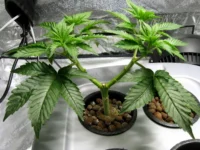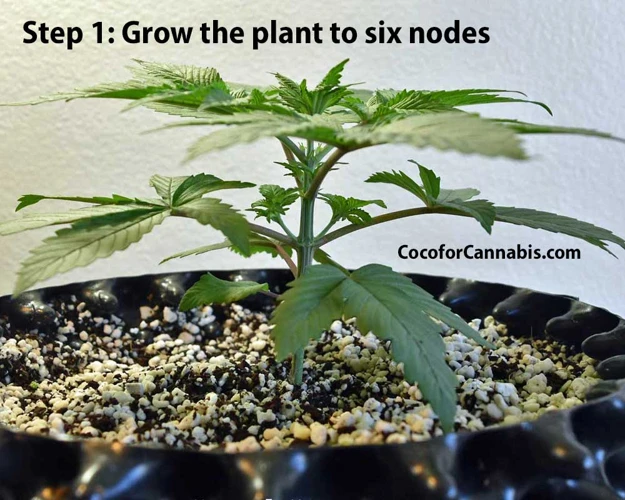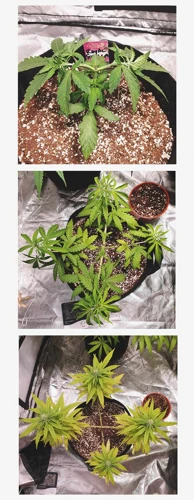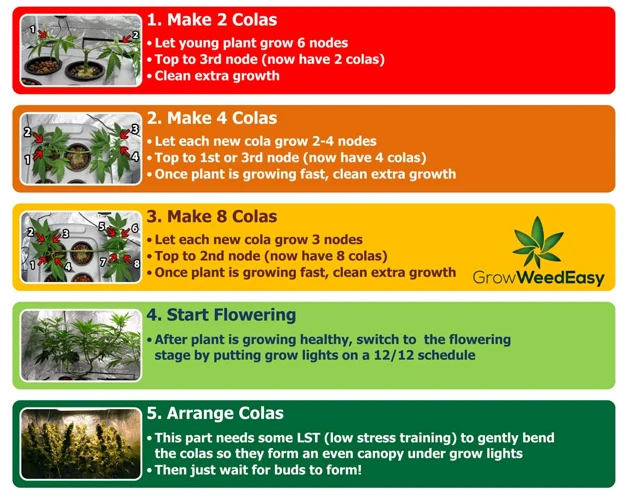
Mainlining Your Cannabis Plants: A Step-by-Step Guide
As a cannabis grower, you may have heard of the term “mainlining” being thrown around in cultivation circles. But what exactly is it, and why are so many growers intrigued by it? Mainlining is a training technique that involves manipulating the plant’s growth pattern to create a symmetrical and efficient canopy of colas. By following a step-by-step guide and understanding the benefits and potential risks, you can successfully mainline your cannabis plants to achieve a higher yield and a healthier crop. So, let’s dive into the world of mainlining and explore how you can implement this method into your cannabis growing routine.
What is Mainlining?
Contents
Have you ever heard of the term “mainlining” in relation to cannabis plants? It might sound like a complicated process, but it’s actually a relatively simple technique that involves manipulating plant growth to create a more uniform canopy. Mainlining essentially involves creating a “hub” at the base of your plant, from which you’ll allow two main branches to grow. By doing so, you can create a more even and efficient use of light, leading to better bud development and overall plant health. But if you’re new to cannabis cultivation, you might be wondering if mainlining is the right choice for you. Let’s explore the benefits of this technique and whether it’s the right fit for your growing style.
The Benefits of Mainlining
Mainlining, also known as manifold or “the perfect storm” technique, is a advanced cannabis growing technique that comes with many benefits. Here are some of the key benefits of mainlining:
- Increased Yield: One of the main benefits of mainlining is the significant boost it provides to your cannabis plant’s yield. By focusing the plant’s energy on fewer colas, mainlining encourages bigger and denser buds, which translates into a healthier and more abundant harvest.
- Better Light Penetration: Mainlining helps to ensure that every part of the plant receives equal distribution of light, as well as better air circulation through the canopy. This leads to the production of more robust and higher quality buds along the entire length of the plant.
- Greater Control of Plant Growth: Mainlining also offers the grower greater control over how the plant grows by manipulating its branches. By removing growth tips and training lower branches to grow upright towards the canopy, you can promote a more even growth that presents fewer complications once it’s time to flower.
- Improved Overall Plant Health: Through selective pruning and training, mainlining helps to create a stronger and sturdier cannabis plant. It also reduces the risk of pests and diseases since it provides better air circulation and light exposure.
These benefits make mainlining a popular choice for growers who want to take their cannabis growing skills to the next level. However, it’s important to note that mainlining is a technique that requires some experience and patience, so it may not be suitable for novice growers.
Is Mainlining Right for You?
Considering if mainlining is right for you involves several factors that need to be taken into account. Here are some things to consider before you decide to mainline your cannabis plants:
- Experience: Mainlining requires a certain level of experience and skill. If you are a novice grower, it might not be the best technique for you to start with.
- Time: Mainlining is a time-consuming process that requires a great deal of attention and patience. If you have a busy schedule or lack the time to devote to your plants, then mainlining might not be the best choice for you.
- Goals: If your goal is to maximize yields and produce high-quality buds, then mainlining might be a great option for you. However, if your main goal is simplicity and ease of care, then a more basic growing technique might be a better choice.
- Space: Mainlining can require more space than other growing techniques. You will need to have enough room to accommodate the extra branches and nodes that result from the process.
- Resources: Mainlining requires a number of resources, including certain tools and materials. If you do not have access to these resources, it could be difficult to successfully mainline your cannabis plants.
Ultimately, the decision to mainline your cannabis plants depends on many different factors. It’s important to carefully consider each of these factors before making a decision. Don’t be afraid to seek advice and guidance from more experienced growers if you’re unsure whether or not mainlining is right for you.
How to Mainline Your Cannabis Plants
If you’re ready to take your cannabis plants to the next level, mainlining may be just the technique for you. This advanced training method involves manipulating your plants to grow into a symmetrical shape with multiple colas. While it may seem complicated, with the right tools and guidance, mainlining can be a rewarding way to improve the overall quality and yield of your cannabis crop. In this section, we’ll provide a thorough guide on how to mainline your cannabis plants step-by-step, so you can achieve the best possible results. Let’s dive in!
What You Need
To successfully mainline your cannabis plants, you will need some essential equipment. Here are the items you should collect before you begin this process:
| Item | Description |
|---|---|
| Scissors/Pruners | A sharp pair of scissors or pruners will allow you to make clean cuts without damaging your plant. |
| Stakes | To support your plant while it’s adjusting to mainlining, you’ll need sturdy stakes or bamboo sticks. |
| Tape/String | Once you’ve made your cuts and positioned your branches, you’ll need something to hold them in place. You can use plant tape or string, whichever you prefer. |
| Clean Surface | Mainlining requires precision, so be sure to work in a well-lit area with a clean surface. You can use a table, counter, or any flat surface that’s easy to clean. |
| Optional: Rooting Hormone | If you plan to reuse the cuttings you remove from your plant, you can dip them in rooting hormone to encourage new root growth. |
Having these tools on hand will help you complete your mainlining process with ease and precision. Having a clean and organized workspace will ensure that you can focus on the mainlining process and avoid any distractions or disruptions.
Step-by-Step Guide
The Step-by-Step Guide to Mainlining Your Cannabis Plants
Mainlining your cannabis plants involves several steps, which must be carefully done to ensure success. Here is a step-by-step guide to help you get started.
| Step 1: Choose the Right Plant | Select a healthy, robust plant that is at least 4-5 weeks old and has strong stem structure. |
| Step 2: Take Cuttings | Take 4-8 cuttings from the plant, making sure to cut at a 45-degree angle just above a node. Remove any lower branches, leaves, or buds from the cuttings. |
| Step 3: Prepare the Cuttings | Dip the cuttings in rooting hormone and plant them in a rooting medium such as rockwool cubes or peat pellets. Keep them in a warm, humid environment with good lighting. |
| Step 4: Choose Two Main Branches | Once the cuttings have developed roots and grown to around 6 inches tall, choose two main branches to mainline. These will become the primary colas of your plant. |
| Step 5: Cut Away Side Branches | Cut away all side branches and nodes from your chosen main branches, leaving only the top two nodes intact. Be sure to use a clean, sharp blade to avoid damaging the stems. |
| Step 6: Top the Stems | Cut off the top of each stem just above the second node, taking care not to damage the remaining nodes. This will encourage new growth and help create a more symmetrical plant. |
| Step 7: Attach Yoyo Supports | Attach Yoyo supports to the main branches and gently pull them outward to create a symmetrical canopy, with the two main branches at the center. Make sure that the Yoyo supports are not too tight, or they may damage the branches. |
| Step 8: Train the Branches | As the plant grows, continue to train the two main branches to grow outward, clipping off any new stems that grow above the second node until you achieve the desired shape and size. |
| Step 9: Flowering and Harvesting | Once your plant reaches the desired size, you can switch it to the flowering stage and harvest when the buds are fully mature. |
Note: Be sure to keep your plant healthy with proper maintenance like regular watering, feeding, and pest control.
Aftercare
Once you have finished mainlining your cannabis plants, proper aftercare is crucial for ensuring their growth and development. Here are some essential steps you should follow:
1. Water your plants properly: After you have completed mainlining, your cannabis plants will require frequent watering. Make sure not to overwater them, as it can lead to mold formation. It’s best to water your plants when the soil is slightly dry to the touch.
2. Monitor your plants: Keep a close eye on your plants for the next few weeks. Watch out for any signs of stress or nutrient deficiencies, such as yellowing leaves or drooping stems.
3. Provide adequate nutrition: During mainlining, your cannabis plants go through a lot of stress, which can deplete their nutrients. Make sure to provide them with the necessary nutrients to help them recover and promote healthy growth.
4. Maintain a clean environment: A clean environment is essential for preventing the growth of mold and pests. Keep your mainlined plants in a well-ventilated area and maintain a clean grow space.
5. Adjust lighting and temperature: Ensure your plants receive adequate light and the temperature is optimal for their growth. Make any necessary adjustments to your grow space to accommodate your recently mainlined plants.
By following these aftercare steps, you will promote healthy growth and development of your mainlined cannabis plants, ensuring that they can reach their full potential.
Common Mistakes to Avoid
Making mistakes during the mainlining process can harm your cannabis plants and ruin your harvest. Avoiding these mistakes is crucial for a successful mainlining experience. However, even experienced growers fall prey to some of these common mistakes. To help you avoid them, we have compiled a list of the most common mistakes and how to prevent them. Read on and ensure that you don’t fall into any of these pitfalls during your mainlining journey.
Over-Manipulation
One common mistake that many novice cannabis growers make when mainlining their plants is over-manipulation. This refers to excessively pruning or cutting the plants, which can ultimately lead to stunted growth or even plant death. It’s important to remember that mainlining should be done gradually and with precision, allowing the plant to adjust to each stage before moving on to the next.
Here are some signs that you may be over-manipulating your cannabis plants during the mainlining process:
- Unhealthy Appearance: If your plant starts to look sickly or shows signs of stress such as yellowing leaves or brown spots, you may be over-manipulating it.
- Slow Growth: Over-manipulation can cause your plant to grow more slowly or stop growing altogether.
- Damaged Nodes: If you accidentally cut or damage a node while pruning, it can also slow the growth of your plant.
To avoid over-manipulation, take things slow and be careful not to remove too many leaves or branches at once. Keep an eye on your plants and monitor their progress along the way to ensure that they are growing well and not showing signs of stress. Remember, less is often more when it comes to pruning and manipulating cannabis plants, and patience is key to achieving successful mainlining.
Improper Timing
Timing is crucial when it comes to mainlining cannabis plants. One of the most common mistakes that growers make is improper timing. This can result in stunted growth or even death of the plant. Here are some key dos and don’ts to follow to ensure proper timing:
- Do: Wait until your plants have at least 4-6 nodes before starting the mainlining process. This ensures that there are enough potential colas to work with.
- Do: Make sure your plants are healthy and well-nourished before beginning. Plants that are weak or struggling will not respond well to the stress of mainlining.
- Don’t: Rush the process. Mainlining takes time and patience, and trying to speed things up can result in damage to the plant.
- Don’t: Mainline during periods of rapid growth or flowering. This can lead to uneven growth and a less productive harvest.
Putting in the effort to get the timing right will pay off in the end with a healthier and more productive plant.
Leaving Behind Nodes
When mainlining your cannabis plants, one common mistake to avoid is leaving behind nodes. Nodes are the points on the stem where leaves and branches grow out from. These can impede the overall structure and development of your cannabis plant if not properly managed during the mainlining process.
Why Leaving Behind Nodes Can Be a Problem
Leaving behind nodes can lead to uneven growth and an unbalanced structure for your cannabis plant. The point of mainlining is to create a symmetrical and even canopy for optimal light exposure and bud development. Nodes can also become competition for the main colas or branches, leading to lower yield and a less productive plant.
How to Avoid Leaving Behind Nodes
To avoid leaving behind nodes, carefully inspect your plants and make sure to remove all growth points that will not contribute to the mainlining structure. This includes any side shoots or branches that grow above the mainline. Use sharp, sterile pruning shears to make clean cuts at the base of each node or branch.
What to Do if You Leave Behind Nodes
If you accidentally leave behind nodes during the mainlining process, don’t panic. Simply observe your plant and check for any uneven growth or competition for the main colas or branches. If you notice any issues, you may need to go back and make additional cuts to remove the excess growth. However, be careful not to over-manipulate the plant, as this can also stress it out and impede growth.
To sum up, when mainlining your cannabis plants, it’s important to avoid leaving behind nodes to ensure even growth and optimal structure. Carefully inspect your plants and make clean cuts to remove any unnecessary growth. If you do leave behind nodes, monitor your plant closely and make additional cuts if necessary, but be careful not to over-manipulate it.
Troubleshooting
Growing cannabis can be a challenging and rewarding experience. However, even the most experienced growers can run into issues with their plants. When it comes to mainlining your cannabis plants, there are a few common problems you may encounter. These issues can cause stunted growth, yellowing leaves, and even plant stress. If you’re troubleshooting your mainlined cannabis plants and feeling perplexed, don’t worry. In this section, we’ll explore the common problems and provide solutions to help you get back on track.
Stunted Growth
If you notice that your cannabis plant is experiencing stunted growth, this could be an indication of a problem with mainlining. Stunted growth occurs when the plant is not getting the nutrients it needs to grow properly, which can lead to a lack of height, small leaves, and a slow development of new growth. This could be caused by several factors, including improper topping, underwatering, or root damage.
To troubleshoot this issue, it is essential to assess the growing conditions of your plants. You can use the following table for guidance:
| Possible Causes | Solutions |
|---|---|
| Improper Topping | Double-check to ensure that you topped the plant correctly. If necessary, revisit step 3 to make sure you didn’t leave any nodes behind. |
| Underwatering | Ensure your plants are getting enough water. Check the soil moisture levels regularly and water the plant whenever it seems dry. |
| Root Damage | Inspect your plant roots to see if they have been damaged or are not getting enough nutrients. You can carefully remove the plant from the container and examine the roots. If they are discolored or mushy, this could be a sign of root rot. In this case, you may need to repot the plant with fresh soil and additional nutrients. |
In any case, it is essential to take action as soon as possible. A stunted plant will not produce a significant harvest, and it could eventually die if left unchecked. By taking note of your plant’s growth patterns and following the troubleshooting steps above, you can ensure that your mainlining process goes smoothly and that you get the most out of your cannabis plants.
Yellowing Leaves
Yellowing leaves can be a common problem when mainlining cannabis plants. It can be caused by various factors, including nutrient deficiencies, overwatering, pH imbalances, and pests. It is essential to identify the underlying cause of yellowing leaves to address the problem effectively.
To diagnose and treat yellowing leaves, it is essential to observe the affected plant’s appearance and growing conditions. The following table highlights some possible causes and remedies for yellowing leaves in mainlined cannabis plants:
| Possible Cause | Symptoms | Remedy |
| — | — | — |
| Nutrient Deficiencies | Yellowing of leaves starting from the bottom and moving upward. | Add nutrients to the soil or change the feeding schedule. Use specialized fertilizers for cannabis plants, which are rich in nitrogen, phosphorus, and potassium. Ensure proper pH and EC levels. |
| Overwatering | Yellowing leaves with soft and limp texture. | Avoid overwatering and allow the soil to dry between watering. Ensure proper drainage and container size. Improve air circulation and humidity levels. |
| pH Imbalances | Yellowing leaves with brown spots, curling, or twisting. | Test soil pH and adjust as necessary. Maintain the proper pH range of 6.0-7.0 for soil and 5.5-6.5 for hydroponic setups. Use suitable pH adjusters and supplements. |
| Pests | Yellowing leaves with holes, webs, or other signs of infestation. | Identify and remove pests manually, use insecticidal soaps, neem oil, or other natural remedies. Prevent pests from entering the growing area and maintain proper hygiene. |
In addition to these remedies, it is crucial to monitor the plant’s progress and adjust the treatment as needed. With proper care and attention, mainlined cannabis plants can recover from yellowing leaves and produce a bountiful yield.
Plant Stress
Plant stress is an inevitable outcome of any intervention in a plant’s growth process, including mainlining. However, it is essential to recognize and troubleshoot stress promptly to prevent long-term damage to the plant. Here are a few common stress symptoms to watch out for, along with their possible causes and remedies.
| Stress Symptom | Possible Cause | Remedy |
|---|---|---|
| Wilting leaves | The plant may be overwatered or underwatered, causing root stress. | Adjust the watering schedule and ensure that the plant gets adequate drainage. |
| Yellowing leaves | The plant may be lacking nutrients or may have root stress. | Check for nutrient deficiencies and consider adding organic fertilizers or compost. Evaluate the watering schedule and ensure that the roots are not damaged. |
| Sudden drooping | The plant may be experiencing shock from over manipulation or transplanting. | Reduce further interventions and allow the plant to recover naturally. Consider providing a light nutrient boost along with a mild foliar spray. |
| Burnt leaves | The plant may be exposed to excessive light or heat. | Adjust the lighting schedule and distance to provide optimal light exposure. Consider using a fan or reducing temperature to reduce heat stress. |
| Stunted growth | The plant may be lacking essential nutrients, or the ambient temperature may be too low or high. | Check for nutrient deficiencies and consider using organic fertilizers. Adjust the temperature and humidity to provide optimal growing conditions. |
It is important to note that plant stress is a natural part of the growth cycle, and some degree of stress is necessary for plants to develop composure and resilience. However, it is essential to monitor stress symptoms and address them promptly to ensure healthy growth and optimal yields. Finding the right balance between intervention and care is key to successful mainlining.
Conclusion
In conclusion, mainlining your cannabis plants is an effective technique for maximizing yields and producing high-quality buds. By utilizing this method, you can create a more even and organized canopy, leading to a more productive and efficient grow.
However, it is important to carefully consider whether mainlining is right for you and your specific growing goals. While there are many benefits to this technique, it may not be suitable for all cultivators or strains.
If you decide to proceed with mainlining, it is essential to follow the proper steps and avoid common mistakes such as over-manipulation, improper timing, and leaving behind nodes. With the right care and attention, your cannabis plants can thrive and produce abundant yields.
Remember to also keep an eye out for any potential issues or signs of stress, such as stunted growth or yellowing leaves. Troubleshooting these problems promptly can help ensure a successful mainlining experience.
In summary, mainlining is a technique that can help elevate your cannabis growing game. With proper preparation, execution, and upkeep, you can enjoy the benefits of this method and produce a bountiful harvest of healthy, potent buds.
Frequently Asked Questions
How long does mainlining take?
Mainlining typically takes between 4-6 weeks, depending on the growth rate of your cannabis plants.
What tools do I need to mainline?
You will need pruning shears, plant ties, and a steady hand.
Can I mainline any strain of cannabis?
Yes, you can mainline any strain of cannabis.
Can I mainline autoflowering plants?
Mainlining autoflowering plants isn’t recommended, as it can cause stunted growth and reduced yields.
How often should I check my mainlined plants?
You should check your mainlined plants daily to ensure proper growth and to catch any issues early on.
Do I need to train my plants after mainlining?
After mainlining, you can continue to train your plants as desired.
Can I mainline plants in hydroponics?
Yes, you can mainline plants in hydroponics.
Is mainlining more difficult than other training techniques?
Mainlining can be more difficult than other training techniques, as it requires precision and attention to detail.
Can mainlining increase my yields?
Yes, by creating a symmetrical canopy, mainlining can increase your cannabis yield.
What should I do if my mainlined plants aren’t thriving?
Check for any issues with your growing environment, adjust your nutrient levels, and consider consulting with a professional cultivator.





